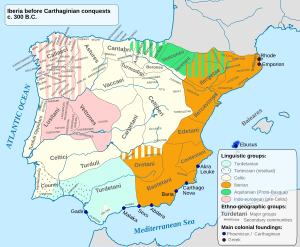Turmodigi facts for kids
The Turmodigi were an ancient group of people who lived in northern Spain a long time ago, even before the Roman Empire became powerful. They were a mix of local people and Celts, and they settled in the valleys of the Arlanzón and Arlanza river during the later part of the Iron Age.
Contents
Where Did the Turmodigi Come From?
The ancestors of the Turmodigi arrived in the Iberian Peninsula (which is modern-day Spain and Portugal) around the 4th century BC. They followed other groups like the Autrigones and Belgae, settling in the area between the Arlanzón and Arlanza rivers.
Historians know about the Turmodigi from old writings. The Roman writer Pliny the Elder called them Turmodigi. Other Roman texts also mention them as Turmogi or Curgoni. In Greek writings, they were called Murbogoioi or Mourbogoi.
What Was Turmodigi Culture Like?
Archaeologists, who study ancient cultures, have found links between the Turmodigi and a cultural group from the early Iron Age called 'Bernorio-Miraveche'. This group lived in the northern parts of what are now Burgos and Palencia provinces.
Recent studies of their main burial ground at Miraveche and other sites show that the Turmodigi culture was strongly influenced by the Celtiberians. They also had many similarities with the 'Duero Culture' of the Vaccei people.
Around the 2nd century BC, the Turmodigi formed a state. Their capital city was Segisama, also known as Segisamone or Segisamum. Today, this place is called Sasamón in Burgos. Other important towns included:
- Sisaraca or Pisoraca (now Herrera de Pisuerga in Palencia)
- Deobrigula or Teobrigula (now Tardajos in Burgos)
- Ambisna (possibly Pampliega in Burgos)
- Bravum or Bravon (near Huermeces, Ubierna, or La Nuez de Abajo in Burgos)
- Mancellus (near Lerma, in the Arlanza river valley)
It's worth noting that some recent studies suggest Pisoraca might have belonged to the Cantabri people, not the Turmodigi.
How Did the Turmodigi Interact with Rome?
The Turmodigi were first under the control of the Autrigones. But around the early 3rd century BC, they broke free with help from the Vaccei. They took over much of the land that is now central and western Burgos province and eastern Palencia province.
Like their neighbors, the Autrigones and Vaccei, the Turmodigi kept their own separate identity until the late 1st century BC. This is when the Romans began to conquer them.
The Roman generals Pompey and Quintus Caecilius Metellus Pius first brought the Turmodigi into the Roman province of Hispania Citerior in 73 BC. However, the Turmodigi were not fully under Roman control until 56 BC. This happened after they joined an uprising with the Vaccei and other groups, which was defeated by the Roman governor Quintus Caecilius Metellus Nepos Iunior.
Later, the Turmodigi faced attacks from the Cantabri and Astures tribes. Because of these threats, they decided to become allies with Rome during the Cantabrian Wars in the late 1st century BC. They even allowed the Roman Emperor Augustus to set up his main base in their capital, Segisama. This made Turmodigia an important rear base for the Romans as they conquered Asturias and Cantabria.
See also
 In Spanish: Turmogos para niños
In Spanish: Turmogos para niños
- Cantabrian Wars
- Sertorian Wars
- Pre-Roman peoples of the Iberian Peninsula


